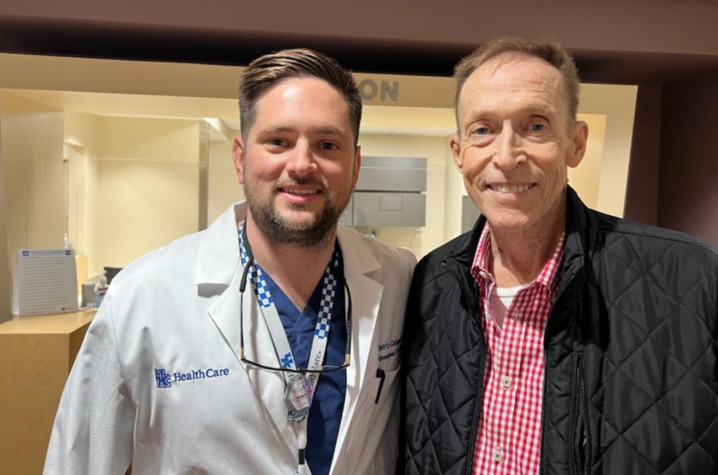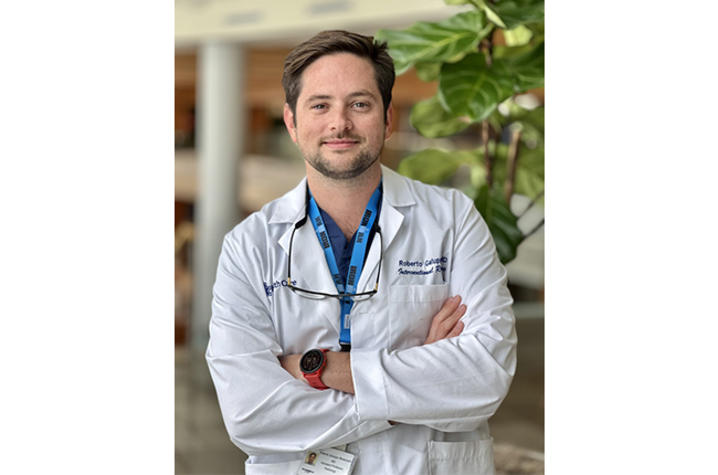'The only alternative is hospice': Radical interventional radiology procedure saves UK patient
LEXINGTON, Ky. (Nov. 3, 2022) — Ron Bird was out of options.
His blood was filled with ammonia, poisoning the rest of his body. He was in and out of the hospital for two years, comatose from the effects of the ammonia. His kidneys were shutting down. His heart was weakened. His brain was in a constant fog. It was suggested that his husband, David, begin looking into hospice care.
Ron had issues with his liver all his life. He was born with a cyst in his liver, reducing its functioning capacity by about two-thirds. Later in life, he was diagnosed with Hodgkin’s lymphoma and while chemotherapy saved his life, it essentially destroyed what was left of his liver.
“It was a perfect storm,” Ron said. “They set me up for a liver transplant. I was very sick and needed a transplant right away.”
That liver lasted about five years before Ron’s body began rejecting it. In 2015, he traveled from his home in Knoxville to the UK Transplant Center for his second transplant. After speaking with Malay Shah, M.D., surgical director of the liver transplant program, they knew that this time, things were going to be different.
“It was the perfect liver,” Ron said. “Dr. Shah said it was the best possible liver.”
But there was a problem. The years of liver disease took a toll on the liver’s major blood vessels. The portal vein, the vessel that carries blood from the spleen, pancreas and intestines to the liver was completely blocked.
“Rather than connect the donor portal vein to Ron’s portal vein, we had to connect the donor portal vein to the inferior vena cava,” said Shah. “This is a completely unconventional way to connect the portal vein, but unfortunately the only option in Ron.”
For the next five years, this solution worked like a charm. Aside from an occasional bout of illness, Ron and David traveled regularly to the Isle of Palms in South Carolina where they would ride bikes along the beach, to New Mexico for David’s work and Abingdon, Virginia, for the Barter Theater. They moved to Washington, D.C., for David’s job and in January of 2020, where they got married in the National Cathedral.
But then Ron’s health took another turn.
“I was often waking up in the hospital,” Ron said.
“He would go into what I call an ammonia coma,” David said. “It would be a matter of hours. He would go from talking and interacting and then be completely out of it. He would end up in the ICU and wake up a couple of days later. This happened six or seven times in the span of two years.”
Each time, the levels of ammonia in Ron’s blood were dangerously high. He was having frequent seizures. In 2020, the cumulative effects of illness took a toll on his heart, and he had to have one valve replaced and two repaired and a pacemaker implanted. His kidneys were in trouble as well. By December of 2021, Ron wasn’t getting any better. He was maxed out on all possible medication and there were no options left.
“I was at wit’s end,” Ron said. “I said, I can’t live like this, to be just constantly waking up in the hospital.”
Ron’s new liver wasn’t the problem — it was working perfectly. So, Shah and the rest of the transplant consulted Roberto Galuppo, M.D., in UK HealthCare’s interventional radiology to check whether the connections made during the liver transplant were still working.
“Initially, on the scans, the connection looked ok,” said Galuppo. “But with time, the inferior vena cava below the constriction essentially gave up, and the blood flow was not going into the liver.”
Ron developed hepatic encephalopathy, a serious disease in which the liver struggles to remove toxins from the bloodstream. In a healthy liver, the portal vein carries waste products from the gut into the liver where they are detoxified, neutralized and excreted. Since Ron’s portal vein was damaged from his prior illnesses, the transplant team had to make new connection using the vena cava, the main blood vessel that carries the filtered blood away from the liver to the heart. This new connection forced blood into the liver to be filtered. It worked for seven years, but the pressure was too much and the flow was reversed — the unfiltered, ammonia-laden blood was being recirculated through the rest of his body.
“It’s fairly uncommon to have situations where a portal vein is clogged to the point where we can’t remove the clot during surgery,” said Shah. “Unfortunately, Ron’s portal vein was completely gone.”
Looking at Ron’s CT scans, Galuppo had an idea.
“We knew this wasn’t a liver issue, it was essentially a plumbing issue,” said Galuppo. “So what if we force the blood coming in from the gut into the liver by artificially creating this connection? Since the blood is flowing into the vena cava, what if we poke a hole in the portal vein and place a shunt and redirect this blood flow. Unfiltered blood was draining into the renal vein, so we close that and force the blood through this new conduit.”
The only problem was Galuppo couldn’t find any record of a procedure such as this. In theory, it would work, but he couldn’t pitch his idea to Ron and David with any statistics or success stories.
“It was risky, but we were confident the stent would hold,” Galuppo said. “I explained the plan to David, who said, 'The only alternative is hospice, so let’s try it.'”
With the help of Chadi Diab, M.D., Merve Ozen, M.D., and the rest of the talented interventional radiologists and staff, Galuppo performed this innovative procedure in December 2021 with remarkable and almost immediate results.
“It started working immediately,” David said. “He had some other issues that kept him in the hospital for a long time, but he hasn’t had an ammonia problem since then.”
Galuppo presented the results of the procedure at the conference of the Society of Interventional Radiology during a session of extreme radiological procedures.
“It was a session where they only present unique cases, where you’re pulling 'Hail Marys' and doing procedures that you wouldn’t normally do to try and save people,” said Galuppo.
Impressed with the results of Galuppo and his team, editor-in-chief for the Journal of Vascular and Interventional Radiology, Ziv Haskal, M.D., invited Galuppo to write a book chapter regarding this procedure for his book “Extreme IR.” Ron is now the textbook definition of interventional radiology ingenuity.
Recovering at home in Knoxville, Ron is looking forward to a trip to the beach. For the first time in a long time, he and David can finally make travel plans.
“It’s amazing,” said Ron. “It’s a miracle. Every time I talk to Dr. Galuppo, I say that he, my donor, Dr. Shah, Dr. Leyson, Dr. Sekala, physician assistant Hender Rojas and all the nurses are my heroes.”
As the state’s flagship, land-grant institution, the University of Kentucky exists to advance the Commonwealth. We do that by preparing the next generation of leaders — placing students at the heart of everything we do — and transforming the lives of Kentuckians through education, research and creative work, service and health care. We pride ourselves on being a catalyst for breakthroughs and a force for healing, a place where ingenuity unfolds. It's all made possible by our people — visionaries, disruptors and pioneers — who make up 200 academic programs, a $476.5 million research and development enterprise and a world-class medical center, all on one campus.






